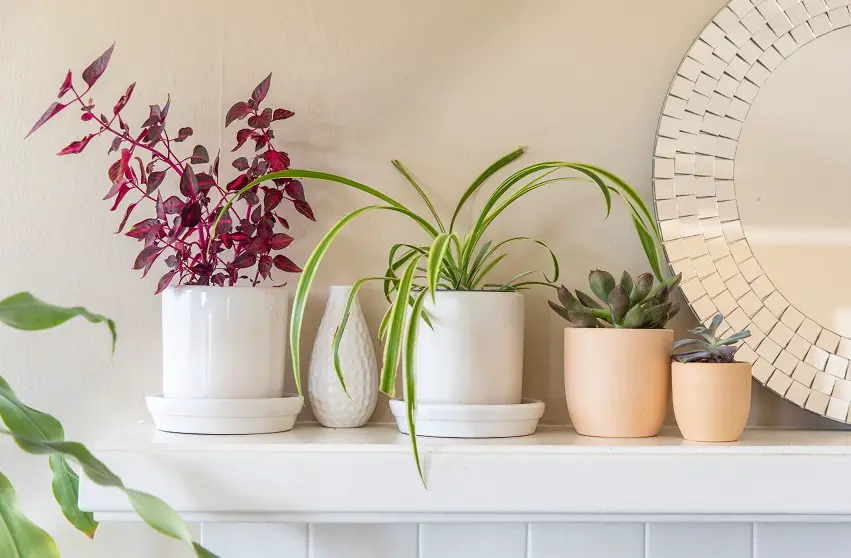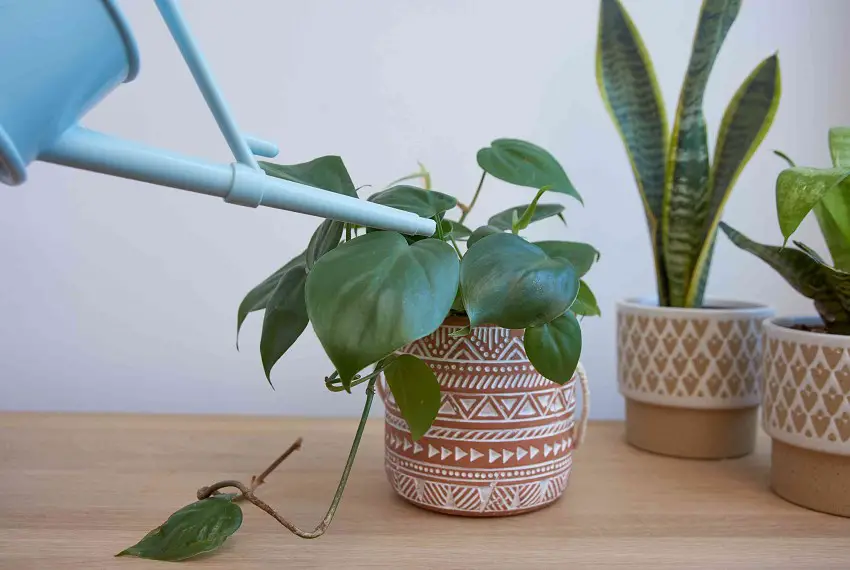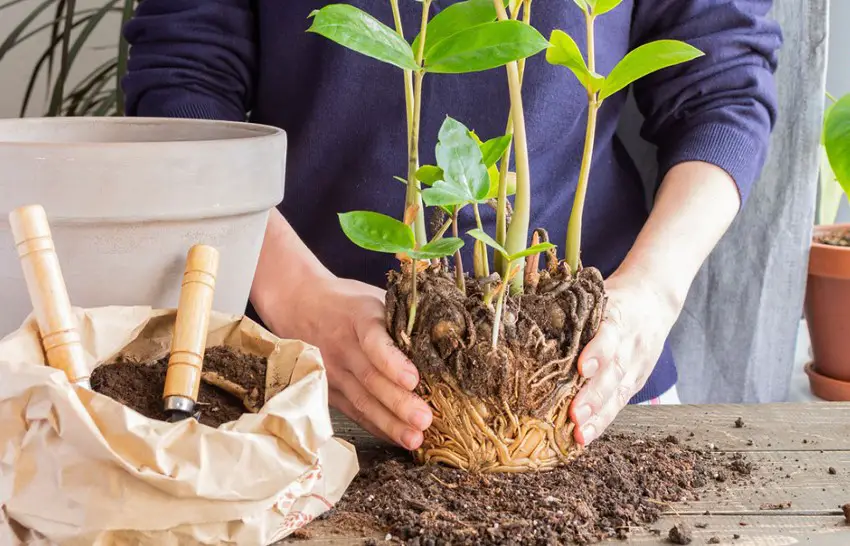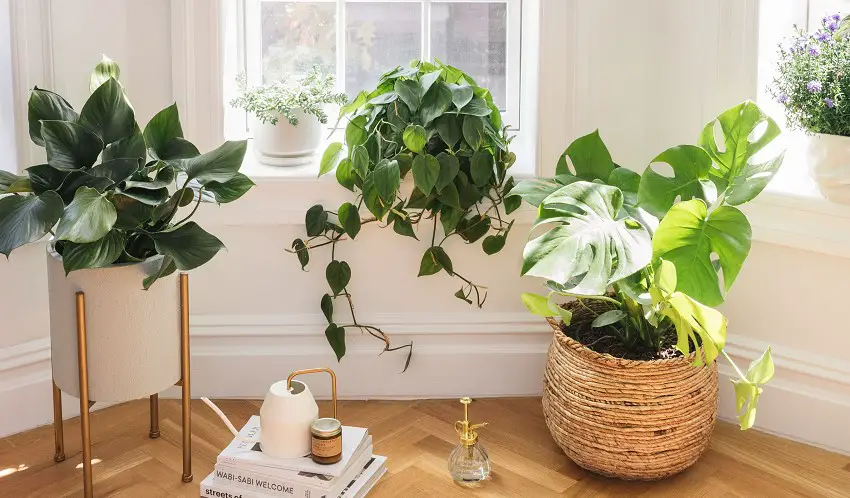Winter is coming, but does this mean we should deny the beauty of indoor plants because of drafty windows with almost no sunlight?
To keep houseplants alive in severe weather conditions you need appropriate temperature, enough light, adequate humidity, poor watering, and additional winter care.

Do plants need extra care?
Moons ago people used to keep their houseplants on the windowsills and shelves all around the house trying to keep them alive until the next spring.
But years passed and the cold weather efficiently sucked the freshness from their previously green and handsome garden. From year to year, this happened due to a lack of proper attention and care.
We spend a lot of time caring for our leafy friends, and the idea of losing them due to extreme winter conditions makes us feel horrible.
It is known that most outdoor plants die off in chilly weather, but there’s no reason for houseplants to have the same destiny.
With extra attention, and some ordinary changes, you can help undergrowth to cope with winter time.
What keeps plants warm in winter?
Advising new gardeners may be simple: reduce watering, give more heat and light, keep plants clean and soil wet, and your houseplants will have better opportunities to survive.
Learn the plant labels
The first step in getting ready for wintertime should be making the research for the requirements of the plants. Various plants can differ significantly in winter maintenance needs.
Some species can stand colder months being wrapped outside due to dormancy periods, other plants love mild conditions with no temperature drop and cold wind.
Some indoor plants can successfully cope with colder temperatures, drafts, and dry heated air inside our homes, and are the best to be cared about.
It could be a good idea to grow the plants which can handle cooler temperatures or temperature changes without a problem. But we choose handsome, flowered, and sensitive species to admire the forest all year long.
Knowing how to care for houseplants in winter is just as essential as planning a winter shrubbery to ensure that your accommodation is filled with vegetable kingdom year round.

Take plants indoors
The next stage is to take plants indoors. It is important to relocate them unless you are certain that these plants can cope with cold weather.
Bring greenery inside while the weather is still warm because they can suffer a great shock of frost.
All vegetation can handle some changes, but they have different resistance levels. So be sure you provide a suitable environment for plant growth in winter.
“The best houseplants in winter are those that are adaptable to cooler temperatures and drier, less humid air,” explains gardening expert Lindsay Pangborn.
Knowing how to maintain your leafy friends over the winter months is essential knowledge for any grower. That is not too tricky, most terms you can easily fulfill in winter.
Thermal conditions
There are three main types of houseplants: tender, hardy, and half-hardy. Tender plants need the warmth of 60 °F, meanwhile, hardy greenery requires 45 °F, and half-hardy prefers 55 °F.
Most flora demands being inside in mind climate to sustain colder winter months.
Many houseplants are sensitive to temperature changes. Suddenly opened windows or cold drafts may harm the plant in winter.
The damage might not be obvious straight away, but it’s something you should be aware of in wintertime.
Meanwhile, some plants can’t tolerate too much heat. So be careful placing them close to heaters, furnaces, or other sources of heat.
Actually, shrubs are afraid of any fluctuating conditions, so keep in mind to find a place for them where they are away from regular climate changes. Try to exclude cold sudden drafts, accidental windy air, as well as radiators and fireplaces.

What temperature is too cold for indoor plants?
Most houseplants are tropical and prefer temperatures from 66-75 °F at night and around 10° cooler. For many plants, the low temperature of 60 °F causes problems.
Cold nights bring an additional challenge to an indoor plant. Even if you have a heater for your houseplants at night, it might not be enough.
If you want the warmth to spread all over the room, try to circulate air with the help of special equipment. It doesn’t cost much but brings a lot of benefits by mixing air inside the room.
Moreover, grow light or lamps bring benefits and may be bought in any local garden center.
What light requirements do plants need in winter?
Choosing the right place for houseplants maintains their best health and natural growth, especially in winter.
On short winter days, most plants lack natural sunbeam, direct sunshine coming through the window.
Windowsills can be the best place for greenery to obtain as much sunshine as possible. Some foliage requires high levels of sunlight, and direct beam, while others prefer indirect sun.
If your indoor plant starts stretching toward its natural light source – it is in lack of sunray and needs another location.
During the cold season, do not forget to control the angle of the sun, and be ready to rotate as it will grow better towards the daylight.
To create an equal shape, keep in mind to change the angle several times a month.
Needless to say, sometimes you may provide additional lighting supplements to help your plant to cope with winter months. Grow lights or fluorescent lamps may also help to correct light levels in your forest space.

Heat sources
Any indoor environment where the sun doesn’t shine for more than four hours a day is not convenient for most vegetation.
Heat lamps for plants are a great alternative to natural sunlight, and allow you to grow a large variety of fresh fruit, houseplants, and greenery all year round.
There are 3 main types of lamps according to its spectrum.
Ultraviolet lamp
Emits ultraviolet light, can be also used as a UV sterilizer for disinfection.
Visible light
It is also called Photosynthetically active radiation or PAR, used by plants in photosynthesis. Also provides full-spectrum growing lights for plants.
Infrared light
It is responsible for giving solar radiation, the heat from the sun.
These lamps are of extra charge and have some pros and cons. But you may choose this option to give your plants the rays they need to grow.
By heating lamps, you may adjust the beam closer to the summery conditions that all plants prefer. It is possible to monitor the thermal and humidity. You can even control it with your smartphone.

Watering indoor plants
Knowing the correct humidity level helps you to care about the garden, especially in cold temperatures.
Most indoor plants require less water and prefer low humidity, and others need more moisture in the air.
Heating makes soil dry out faster and brings dry air. But overwatering may lead to even worse root rot.
To adjust humidity levels, you may test the top inch of the soil with a finger to check whether it’s dry or not.
Sprayingfoliage regularly with a simple pulverizer and placing it in a tray packed with pellets, gravel, pebbles, and water may also help bring extra moisture.
Using a humidifier for adding moisture into the air provides freshness to houseplants.
Tap water may also support your home garden in the wintertime.
It may also be a good idea to organize a different room for tropical plants that require high humidity in winter.

Cleaning plants
Needless to say that cleaning is as much important as keeping indoor plants healthy.
All vegetation tends to accumulate dust on its foliage all year long. Proper care and washing are required for plants in winter.
Dust can diffuse or block light, which leads to absorbing less light in your room. It is important to wash the leaves regularly with warm water.
Moreover, a dust-free environment helps to prevent your houseplants from pests such as mealy bugs.
There is no need to buy extra washings, use a drop of simple soap to wash the leaves. Take a gentle sponge and do not forget to wipe the undersides of the foliage.
Fertilizers
Different plants have different requirements you need to fulfill to provide your leafy friend suitable conditions for plant growth.
Sometimes you may notice that indoor plants go dormant during the winter. Or put all leaves down. This helps them to stay alive all winter long.
That doesn’t mean soil requires additional nutrition, fertilizing indoor plants is often not recommended in winter. You’d better stop fertilizing. But if you decide to feed the soil, be sure you use a small number of nourishing components.
There is no need to worry about the plant’s growth in winter. It is usually slow.
Repotting
Keeping indoor plants alive and healthy is needless to report them. Transplanting houseplants may cause new growth that can be weak and exhausting for plants in winter.
In case you emergently need to repot until early spring, for instance when the plant suffers because it’s pot-bound, provide extra care and less stress to the plant.

How do you keep plants warm on a cold night?
Most plants require grow light and ideal temperature, especially at night, as darkness and extra chill do not contribute to better grow in winter.
In most cases, the plant requires extra heating sources on a cold night, but be sure you locate the pot far from extra heaters.
Keep in mind to use a space heater for good winter care if it is not warm enough. Heating vents are also popular to mix the air by raising the thermal.
Space heaters can be electric, fuel-based, infrared, or oil-filled. You may choose the one up to your budget.
Other ways to keep tropical plants warm in winter
Inside warmth and space heaters are sometimes not enough to keep indoor plants alive. You may use bubble wrap and a heat mat as an extra option in winter. Bubble wrap is successfully used for wrapping the pots. There is no need to cover every leaf, it works to insulate the soil to warm it.
Seedling heat mats are another way to protect plants in winter. You need to pop your flora on the heat mat, and it will snug for the frosty season.
Thermal foil is another available option to keep houseplants warm. It is usually made of reflective mylar, which is moderate and simple to be used even for an indoor plant.
You may wrap the pots of your houseplants with thermal foil to create heat spots.
Generally speaking, at home, you may find different means to warm the plant, no matter if it’s an old blanket or very expensive heat mats, be sure you do not harm the foliage and keep the soil warm in winter.
How do I keep my indoor plants alive during winter?
My vegetable kingdom is my pride that is pleasant to the eye. I always take care of it before the winter months come. The most important is to take plans inside in advance, cause not all species can tolerate cold at all.
I do not have a separate room, but windowsills and shelves serve the best to keep my houseplants alive. Poor watering, controlled heating and cleaning help my plants thrive even during winter.
I never repot or fertilize in winter, plants’ growth rate is slow inside, especially in winter.
But I always rotate my plants due to the lack of light from the window.
There is one more that is not suitable for any houseplant, once or twice a month, I shower my shrubbery. It helps to clean, to fresh and to water them properly.

Conclusion
Answering the question, of how to keep indoor plants warm in winter, is to get appropriate knowledge according to the plant label.
In winter, every creature may have good or bad days due to worsening weather conditions, reduced sunshine, falling leaves outside, and dull scenery outside the window. But that is all temporary.
There is no need to make a close search to learn that every plant requires extra humidity, proper light, heat, and watering in winter to brighten our day. Our main aim is to give them additional attention that is not complicated at all.
We should not forget about the dormitory period. It is a protection in some way, and if you notice that your leafy friend looks dull or stressed but all the requirements and conditions are fulfilled, you’d better give it time to accept a new life position.
Do not forget to keep an eye out for pests. The main types of pests affect indoor plants in winter. Cleaning, grow lights, gentle washing with a tender sponge, and additional love will help them to overcome those cold chilly days up to the new growing season.
- Why Are There Still No Tomatoes in My Tomato Plants? Let’s Fix the Issue! - July 13, 2023
- Water Propagation White Stuff on Roots: Everything You Should Know! - July 11, 2023
- String of Dolphins Drying Up: Solved! - July 11, 2023

Pingback: Lavender Cold Tolerance: Best Helpful Tips & Review
Pingback: 26 Best Sansevieria Varieties: Recommendations & Prof Tips